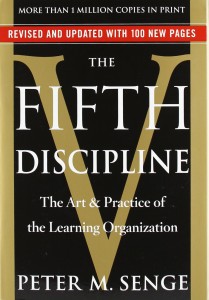“A great teacher is someone around whom others learn. Great teachers create space for learning and invite people into that space.” Peter Senge, The Fifth Discipline: The Art and Practice of the Learning Organization
The Fifth Discipline: The Art and Practice of the Learning Organization by Peter Senge is an excellent read for anyone that desires to study systems thinking, vision, mastery, and learning. This book is a great combination of sound business principles as well as a primer for those desiring to create..or build on…a culture of thinking and learning. This is a big book, but a super easy read. I read it in an evening because the text flows so well around the theme of creating a thinking and learning culture.
I highlighted several things while reading and have posted those notes below…
- The organizations that will truly excel in the future will be the organizations that discover how to tap people’s commitment and capacity to learn at all levels in an organization.
- An organization’s commitment to and capacity for learning can be no greater than that of its members.
- When teams are truly learning, not only are they producing extraordinary results, but the individual members are growing more rapidly than could have occurred otherwise.
- The most powerful learning comes from direct experience.
- We all tend to blame someone else—the competitors, the press, the changing mood of the marketplace, the government—for our problems. Systems thinking shows us that there is no separate “other”; that you and the someone else are part of a single system. The cure lies in your relationship with your “enemy”.
- Seeing the major interrelationships underlying a problem leads to new insight into what might be done.
- Don’t push growth; remove the factors limiting growth.
- People with a high level of personal mastery live in a continual learning mode. They never “arrive.”
- The principle of creative tension is the central principle of personal mastery, integrating all elements of the discipline. Yet, it is easily misunderstood. For example, the very term “tension” suggests anxiety or stress. But creative tension doesn’t feel any particular way. It is the force that comes into play at the moment when we acknowledge a vision that is at odds with current reality.
- A mistake is an event, the full benefit of which has not yet been turned to your advantage.
- The sense of connectedness and compassion characteristic of individuals with high levels of personal mastery naturally leads to a broader vision. Without it, all the subconscious visualizing in the world is deeply self-centered—simply a way to get what I want.
- At its simplest level, a shared vision is the answer to the question, “What do we want to create?” Just as personal visions are pictures or images people carry in their heads and hearts, so too are shared visions pictures that people throughout an organization carry. They create a sense of commonality that permeates the organization and gives coherence to diverse activities.
- A shared vision, especially one that is intrinsic, uplifts people’s aspirations.
- Organizations intent on building shared visions continually encourage members to develop their personal visions.
- Vision paints the picture of what we want to create. Systems thinking reveals how we have created what we currently have.
- There are two primary types of discourse, dialogue and discussion. Both are important to a team capable of continual generative learning, but their power lies in their synergy, which is not likely to be present when the distinctions between them are not appreciated.
- In dialogue, people become observers of their own thinking.
- A unique relationship develops among team members who enter into dialogue regularly. They develop a deep trust that cannot help but to carry over to discussions. They develop a richer understand of the uniqueness of each person’s point of view. Moreover, they experience how larger understandings emerge by holding one’s own point of view “gently.” They learn to master the art of holding a position, rather than being “held by their positions.” When it is appropriate to defend a point of view, they do it more gracefully and with less rigidity, that is without putting “winning” as a first priority.
- In great teams conflict becomes productive.
- The commitment to personal growth is important—and it is most important for those in positions of leadership.
- Leaders who appreciate organizations as living systems approach design work differently. They realize that they can create organizational artifacts like new metrics, or formal roles and processes, or intranet Web sites, or innovative meetings—but it is what happens when people use the artifacts or processes or participate in the meetings that matters.
- A great teacher is someone around whom others learn. Great teachers create space for learning and invite people into that space.
- “The innovations that will have the big impact will be ones that integrate complete value chains around securing long term viability for social and ecological as well as economic systems.” Darcy Winslow, NIKE
- Our interconnected world confronts all societies with a mandate to revive the capacity to talk together and live together.
- “To be a teacher is to be a prophet. We are not preparing children for the world we have lived in but for a future that we can barely imagine.” Gordon Brown, Former dean of the MIT Engineering School and champion of systems thinking

